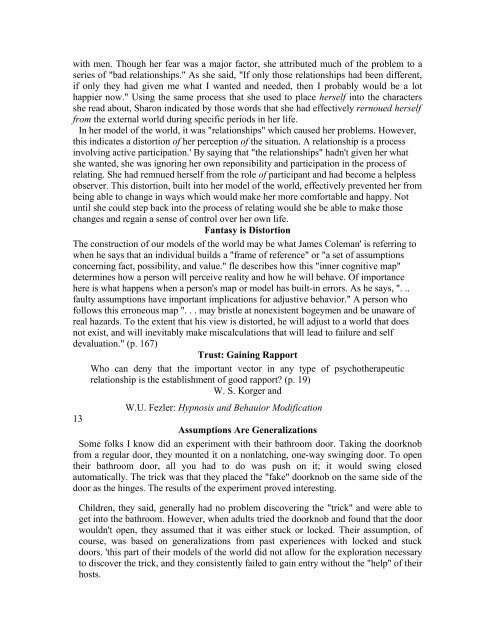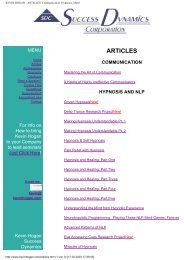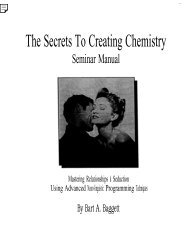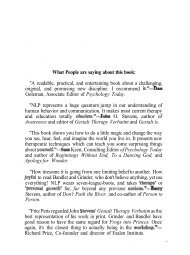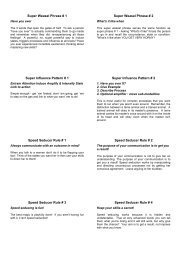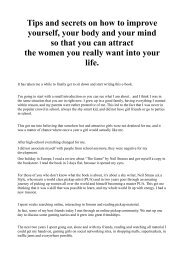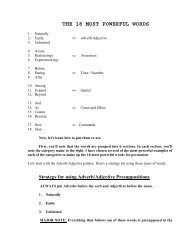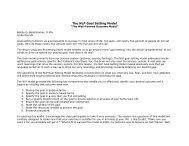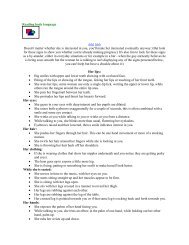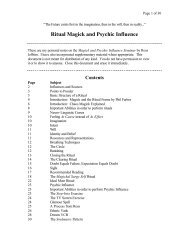A Pragmatic Guide To Communication & Change.pdf - NLP Info Centre
A Pragmatic Guide To Communication & Change.pdf - NLP Info Centre
A Pragmatic Guide To Communication & Change.pdf - NLP Info Centre
- No tags were found...
You also want an ePaper? Increase the reach of your titles
YUMPU automatically turns print PDFs into web optimized ePapers that Google loves.
with men. Though her fear was a major factor, she attributed much of the problem to a<br />
series of "bad relationships." As she said, "If only those relationships had been different,<br />
if only they had given me what I wanted and needed, then I probably would be a lot<br />
happier now." Using the same process that she used to place herself into the characters<br />
she read about, Sharon indicated by those words that she had effectively rernoued herself<br />
from the external world during specific periods in her life.<br />
In her model of the world, it was "relationships" which caused her problems. However,<br />
this indicates a distortion of her perception of the situation. A relationship is a process<br />
involving active participation.' By saying that "the relationships" hadn't given her what<br />
she wanted, she was ignoring her own reponsibility and participation in the process of<br />
relating. She had remnued herself from the role of participant and had become a helpless<br />
observer. This distortion, built into her model of the world, effectively prevented her from<br />
being able to change in ways which would make her more comfortable and happy. Not<br />
until she could step back into the process of relating would she be able to make those<br />
changes and regain a sense of control over her own life.<br />
Fantasy is Distortion<br />
The construction of our models of the world may be what James Coleman' is referring to<br />
when he says that an individual builds a "frame of reference" or "a set of assumptions<br />
concerning fact, possibility, and value." fle describes how this "inner cognitive map"<br />
determines how a person will perceive reality and how he will behave. Of importance<br />
here is what happens when a person's map or model has built-in errors. As he says, ". ..<br />
faulty assumptions have important implications for adjustive behavior." A person who<br />
follows this erroneous map ". . . may bristle at nonexistent bogeymen and be unaware of<br />
real hazards. <strong>To</strong> the extent that his view is distorted, he will adjust to a world that does<br />
not exist, and will inevitably make miscalculations that will lead to failure and self<br />
devaluation." (p. 167)<br />
Trust: Gaining Rapport<br />
Who can deny that the important vector in any type of psychotherapeutic<br />
relationship is the establishment of good rapport? (p. 19)<br />
W. S. Korger and<br />
W.U. Fezler: Hypnosis and Behauior Modification<br />
13<br />
Assumptions Are Generalizations<br />
Some folks I know did an experiment with their bathroom door. Taking the doorknob<br />
from a regular door, they mounted it on a nonlatching, one-way swinging door. <strong>To</strong> open<br />
their bathroom door, all you had to do was push on it; it would swing closed<br />
automatically. The trick was that they placed the "fake" doorknob on the same side of the<br />
door as the hinges. The results of the experiment proved interesting.<br />
Children, they said, generally had no problem discovering the "trick" and were able to<br />
get into the bathroom. However, when adults tried the doorknob and found that the door<br />
wouldn't open, they assumed that it was either stuck or locked. Their assumption, of<br />
course, was based on generalizations from past experiences with locked and stuck<br />
doors. 'this part of their models of the world did not allow for the exploration necessary<br />
to discover the trick, and they consistently failed to gain entry without the "help" of their<br />
hosts.


